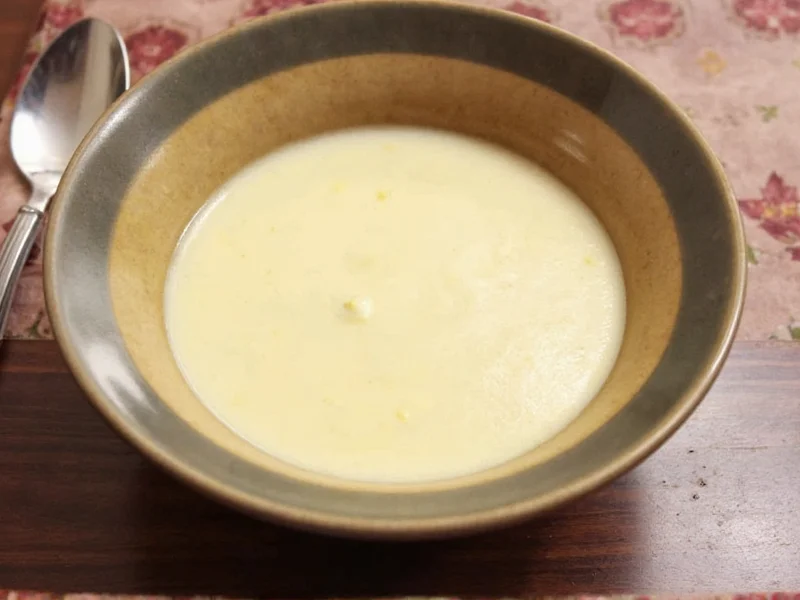A well-crafted cream soup base serves as the essential building block for countless restaurant-quality soups in both professional and home kitchens. Understanding its composition and applications transforms your cooking capabilities, allowing for greater control over flavor, texture, and dietary requirements compared to commercially processed alternatives.
Understanding Cream Soup Base Components
The fundamental structure of a cream soup base consists of three critical elements working in harmony:
| Component | Function | Common Variations |
|---|---|---|
| Roux (fat + flour) | Thickening agent that prevents separation | Butter, bacon fat, olive oil; all-purpose or gluten-free flour |
| Fluid base | Creates soup volume and carries flavor | Stock, broth, milk, cream, or plant-based alternatives |
| Aromatics & seasonings | Provides depth and complexity | Onion, garlic, herbs, spices, wine, nutritional yeast |
Professional chefs often prepare homemade cream soup base without flour using alternative thickeners like pureed vegetables or cornstarch for gluten-sensitive diners. The classic ratio for a standard base is 1:1:10 (one part roux to ten parts liquid), though this varies based on desired thickness and application.
Cream Soup Base vs. Similar Culinary Elements
Many home cooks confuse cream soup base with related but distinct culinary components. Understanding these differences ensures proper usage in recipes:
- Cream of soup products - Commercially canned versions containing preservatives, stabilizers, and often high sodium levels, unlike a pure scratch-made cream soup base
- Roux alone - The cooked fat-flour mixture before liquid is added; roux is merely the thickening component of the complete base
- Velouté - A French mother sauce using roux with stock (typically poultry or fish), which serves as the foundation for many cream soup bases
- Bechamel - A white sauce using roux with milk, forming the basis for cheese sauces and some cream soups
Practical Applications in Home Cooking
A versatile cream soup base for casseroles elevates everyday dishes with minimal effort. When developing your cream soup base recipe from scratch, consider these professional applications:
Classic Soup Development
Transform your base into specific soups by adding complementary ingredients:
- Cream of mushroom - Sautéed mushrooms and thyme
- Cream of broccoli - Steamed broccoli florets and a touch of nutmeg
- Asparagus bisque - Pureed asparagus and lemon zest
- Chicken velouté - Shredded cooked chicken and tarragon
Beyond Soups: Creative Uses
Professional kitchens utilize cream soup base in unexpected ways that home cooks can easily replicate:
- As a sauce foundation for proteins (add wine reduction and herbs)
- Thinned for creamy salad dressings
- As a binder in gratins and casseroles
- Base for creamy pasta sauces (add parmesan and pepper)
- Moisture component in savory breads and biscuits
Creating Your Own Cream Soup Base
Mastering a basic cream soup base recipe requires attention to technique rather than expensive ingredients. Follow these steps for consistent results:
- Melt 4 tablespoons of unsalted butter in a heavy-bottomed saucepan over medium heat
- Add 4 tablespoons of all-purpose flour, whisking constantly for 2-3 minutes to cook out raw flour taste (blond roux stage)
- Gradually incorporate 4 cups of warm chicken or vegetable stock while whisking vigorously
- Add 1 finely diced shallot, 1 minced garlic clove, and 2 sprigs of thyme
- Simmer gently for 15-20 minutes until thickened and flavors meld
- Strain through a fine-mesh sieve for ultra-smooth texture
- Season with salt, white pepper, and a splash of sherry (optional)
For a dairy-free cream soup base alternative, substitute full-fat coconut milk for dairy cream and use olive oil instead of butter. The key to cream soup base without MSG is building flavor through proper caramelization of aromatics and using high-quality stock.
Troubleshooting Common Issues
Even experienced cooks encounter challenges when preparing cream soup bases. Here's how to address frequent problems:
- Lumpy texture - Always cook the roux thoroughly before adding liquid, and whisk constantly while incorporating stock. If lumps form, immediately strain the base.
- Floury taste - Insufficient roux cooking time; cook the roux 1-2 minutes longer next time until it develops a nutty aroma.
- Too thin - Simmer uncovered to reduce and thicken, or prepare a small additional roux (1 tbsp butter + 1 tbsp flour) and whisk it in.
- Too thick - Gradually add warm stock or milk until desired consistency is reached.
- Broken sauce - If the base separates, remove from heat, add a splash of cold water, and vigorously whisk to re-emulsify.
Storage and Shelf Life Guidelines
Proper storage extends the usability of your homemade cream soup base:
- Refrigeration: Store in airtight container for up to 4 days
- Freezing: Portion into ice cube trays, then transfer to freezer bags for up to 3 months
- Reheating: Warm gently over low heat, whisking frequently to prevent scorching
- Revitalizing: If separation occurs during storage, whisk in 1-2 tablespoons of cold liquid while reheating
For meal preppers, creating a large batch cream soup base saves significant time during busy weeks. Freeze in recipe-sized portions (typically 2-4 cups) for instant soup starters or sauce bases.
Adapting for Dietary Restrictions
Modern kitchens require flexibility. These adaptations maintain quality while accommodating special diets:
- Gluten-free cream soup base - Substitute rice flour or cornstarch (use 2 tablespoons cornstarch mixed with 2 tablespoons cold liquid per 4 cups base)
- Vegan cream soup base - Use coconut oil or vegan butter with plant-based milk and nutritional yeast for umami
- Low-sodium version - Use homemade low-sodium stock and enhance flavor with lemon juice, herbs, and mushrooms
- Keto-friendly base - Replace flour with xanthan gum (1/4 teaspoon per 4 cups liquid) and use heavy cream
Understanding how to modify your cream soup base ingredients ensures everyone at your table enjoys restaurant-quality results regardless of dietary needs.











 浙公网安备
33010002000092号
浙公网安备
33010002000092号 浙B2-20120091-4
浙B2-20120091-4